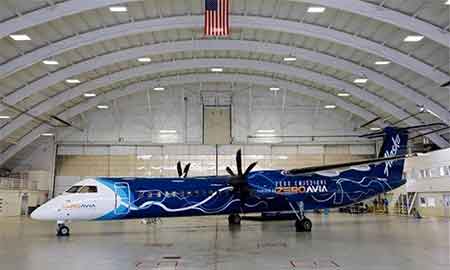 It’s not every day that a legendary airline and an industry disruptor join forces to change the way we think about the future of air travel.
It’s not every day that a legendary airline and an industry disruptor join forces to change the way we think about the future of air travel.
But that’s just what happened this week as Alaska Airlines handed the keys of a de Havilland Dash-8 Q400 over to ZeroAvia in Everett. The 76-seat aircraft will serve as a demonstrator and test platform for the largest zero-emissions aircraft ever to take flight—the power source: a hydrogen-electric hybrid built around four 900-kilowatt electric engines.
While the aircraft isn’t ready to take flight just yet, ground testing of the engines and propellers is already underway at ZeroAvia’s research and development center in Everett. At the handover ceremony, the company showed off the testbed, a large truck with two engines connected to a Dash-8 prop. Dignitaries and company officials were impressed by how quiet the engine run-up was, even at full power.
“What you are witnessing here today is something that years from now, you will look back and say this is the time when the transformation of real large aircraft, real commercial aircraft started,” said Val Miftakhov, ZeroAvia CEO.
Governor Jay Inslee, who was at the ceremony, added, “The largest hydrogen-powered commercial aircraft is being developed right here in the greatest, most innovative state, the state of Washington.”
While the company’s operations extend to California and the United Kingdom, its Washington roots run deep. Alaska Airlines is an investor and partner and shares a hangar with the company at Everett’s Paine Field. Bill Gates’ Breakthrough Energy Ventures is ZeroAvia’s largest shareholder, and Amazon’s Climate Pledge Fund has also made numerous investments in the company.
The Dash 8 is a quantum leap in scale and complexity for ZeroAvia. The company began testing its technologies on a six-seat hydrogen-powered electric plane in 2020 and began testing using a 19-seat Dornier this year.
The Dash 8 will hydrogen fuel cells to generate the electricity to power the motors hung beneath each wing. The company is also developing the technologies required to store liquid hydrogen on the ground and in flight. The fuel cells use proton-exchange membrane for the onboard fuel cells onboard that power the four 900-kilowatt motors.
While the public may still think about the spectacular demise of the airship Hindenburg when they think of hydrogen, advances have caught up with its initial promise. Already, hydrogen-powered cars are plying the nation’s highways. The advances needed to ply the skyways aren’t a huge leap.
The company hopes to begin flight tests next year and enter commercial production by 2028.
Washington State is becoming a key player in developing and using sustainable and alternative fuels to reduce carbon emissions. Universal Hydrogen in Moses Lake is also prepping a Dash 8 turboprop to start flight tests later this year. It has partnered with Everett-based MagniX, which will provide the electric engines for the aircraft. The nine-passenger, all-electric Alice developed by Eviation uses MagniX’s 640-kilowatt power source. The Arlington-made plane began test flights in 2022 in Moses Lake.
To spur additional innovation, the state’s legislature included $6.5 million in the state budget to create a low-carbon fuel R&D center in Everett to support the state’s growing Sustainable Aviation Fuels industry. Washington is also pursuing funding to be one of the nation’s Hydrogen Hubs. The U.S. government plans to designate 10 such hubs in the next year.